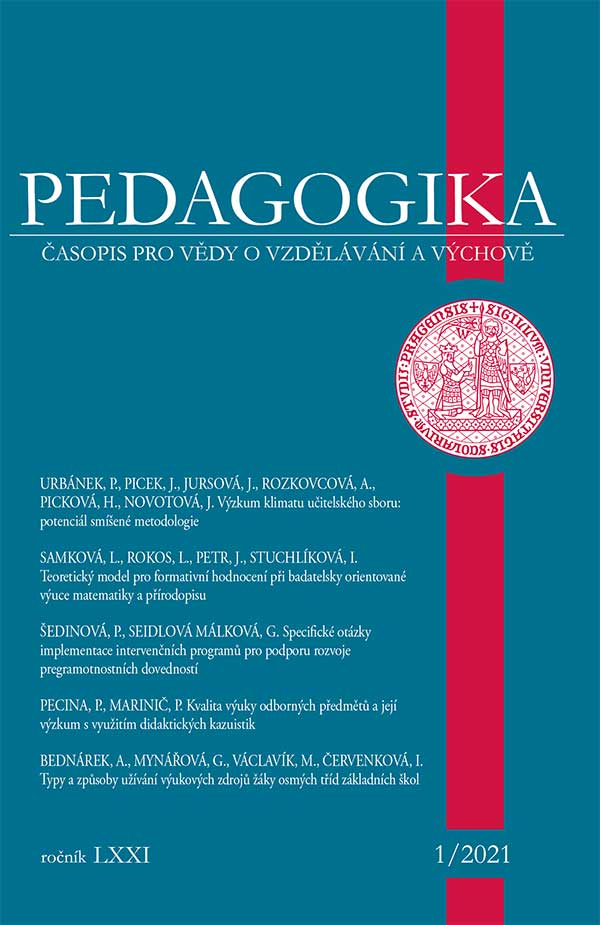Ways and Purposes of Using Teaching and Learning Resources by Lower Secondary School Students
DOI:
https://doi.org/10.14712/23362189.2020.1871Keywords:
educational media, teaching and learning resources, printed and digital resources, use of resourcesAbstract
This paper presents the results of empirical research which focused on types and usage of teaching and learning material used by pupils of the eighth grade of basic school. The contribution aims to describe teaching and learning resources used by lower secondary pupils, as well as to introduce the ways in which such materials are used in classrooms and during home preparation in the subjects of Czech Language, English Language, and History. In addition to that, the contribution aims to assess tendencies in the area of their usage with respect to the penetration of digital technologies into various areas of pupils’ learning. A qualitative methodological design was used for the research. In-depth interviews were conducted with 20 lower secondary (eighth-grade) pupils. The data that was collected was coded, analysed, and interpreted with respect to the aims and questions of the research.
The empirical research has shown that pupils use various teaching and learning resources. On the one hand, in the classroom, use of the textbook is still crucial, and pupils work with the resources individually. On the other hand, during home preparation they tend rather to use their notes from lessons or the internet. Digital resources are regularly used in the classroom as well as at home, but they are not considered dominant. There is a difference in the ways in which individual resources are used in classroom and during home preparation.
The results confirm the tendency in the area of the usage of teaching and learning resources at lower secondary school level. This characterises the heterogeneity among the materials. In the classroom, digital resources are used as a supplement to printed ones, while during home preparation pupils prefer written resources.
References
Cohen, L., Manion, L., & Morrison, K. (2011). Research methods in education. London: Routledge.
Cooper, H. (1994). The battle over homework: Common ground for parents and administrators. Thousand Oaks: Corwin Press.
Červenková, I., & Sikorová, Z. (2014). Strategie žáků s textovými materiály při domácí přípravě na výuku. In J. Poláchová Vašťatková, E. Dvořáková Kaněčková (Eds.), Pedagogický výzkum: spojnice mezi teorií a praxí (s. 59-71). Olomouc: Gevak.
Darn, S. (2007). Homework seems to be an accepted part of teachers' and students' routines, but there is little mention of it in ELT literature. Dostupné z www.teachingenglish.org.uk
deCarvalho, M. E. (2000). Rethinking family-school relations: A critique of parental involvement in schooling. New York: Routledge.
https://doi.org/10.4324/9781410600332
DeCesare, M. (2007). A textbook approach to teaching: Structural uniformity among american high school sociology courses. American Sociologist, 38, 178-190.
https://doi.org/10.1007/s12108-007-9007-9
Flick, U. (2006). An introduction to qualitative research. Thousand Oaks: Sage.
Gavora, P. (2008). Model činnosti žiaka pre učenie sa z učebnice. In P. Knecht, T. Janík et al. Učebnice z pohledu pedagogického výzkumu (s. 121-135). Brno: Paido.
Horsley, M., & Sikorová, Z. (2014). Classroom teaching and learning resources: International Comparisons from TIMSS. A preliminary review. Orbis scholae, 8(2), 43-60.
https://doi.org/10.14712/23363177.2015.65
Horsley, M., & Walker, R. (2006). Video based classroom observation systems for Examining the use and role of textbooks and teaching materials in learning. In É. Bruillard et al., Caught in the web or lost in the textbook? 8th International Conference on Learning and Educational Media (s. 263-268). Caen: IUFM.
Horsley, M., & Walker, R. (2013). Reforming homework: Practices, learning and policy. South Yarra: Palgrave Macmillan.
Churchill, D. (2017). Digital resources for learning. Singapore: Springer.
https://doi.org/10.1007/978-981-10-3776-4
Johnsen, E. B. (1997). Textbooks in the kaleidoscope. Oslo: Scandinavian University Press.
Klubal, L., Kostolányová, K., & Gybas, V. (2017). Using tablet and iTunes as individualized instruction tools. In Proceedings of the 13th International Conference Mobile Learning, Budapest (s. 139-142). Budapest, Hungary: IADIS Press
Instruction Tools. In Mobile Learning 2017: Proceedings of the 13th International Conference on Mobile Learning 2017 (s. 139-142). Budapest: IADIS Press.
Lambert, D. (1999). Exploring the use of textbooks in KS3 geography classrooms: A small scale study. The Curriculum Journal, 10, 85-105.
https://doi.org/10.1080/0958517990100107
Lister, M., Dovey, J., Giddings, S., Grant, I., & Kelly, K. (2009). New media. A critical introduction. 2. vyd. London: Routledge.
Matthes, E., Schütze, S., & Wiater, W. (Eds.). (2013). Digitale Bildungsmedien im Unterricht. Bad Heilbrunn: Julius Klinkhardt.
Nicholls, J. (2005). The philosophical underpinnings of school textbook research. Paradigm, 3(1), 25-35.
Průcha, J. (Ed.). (2009). Pedagogická encyklopedie. Praha: Portál.
Roth, K. J. et al. (2006). Teaching science in five countries: Results from the TIMSS Video Study Statistical Analysis Report. U.S. Department of Education, Institute of Education Sciences, National Center for Education Statistics. Dostupné z https://nces.ed.gov/pubs2006/2006011.pdf
Schaub, H., & Zenke, K. G. (2000). Wörterbuch Pädagogic. München: Deutscher Taschenbuch.
Sigurgeirsson, I. (1992). The role, use and impact of curriculum materials in intermediate level icelandic classrooms. (Dizertační práce). Brighton: University of Sussex.
Sikorová, Z. (2010). Učitel a učebnice: Užívání učebnic na 2. stupni základních škol. Pedagogická fakulta Ostravské univerzity.
Sikorová, Z., Václavík, M., & Červenková, I. (2019). Užívání tištěných a digitálních zdrojů v práci učitelů 2. stupně ZŠ: hybridizace a remixování. Studia paedagogica, 24(3), 111-129.
https://doi.org/10.5817/SP2019-3-5
Stará, J., & Krčmářová, T. (2014). How teachers reflect on textbook materials and how they utilise them. IARTEM e-Journal, 6(3), 67-87.
Švaříček, R., & Šeďová, K. et al. (2007). Kvalitativní výzkum v pedagogických vědách. Praha: Portál.
Wikman, T., & Horsley, M. (2012). Down and up: Textbook research in Australia and Finland. IARTEM e-Journal, 5(1), 45-53.
TIMSS (2016). Mezinárodní šetření TIMSS 2015. Dostupné z www.csicr.cz
Downloads
Published
Versions
- 2021-04-08 (2)
- 2021-04-08 (1)



